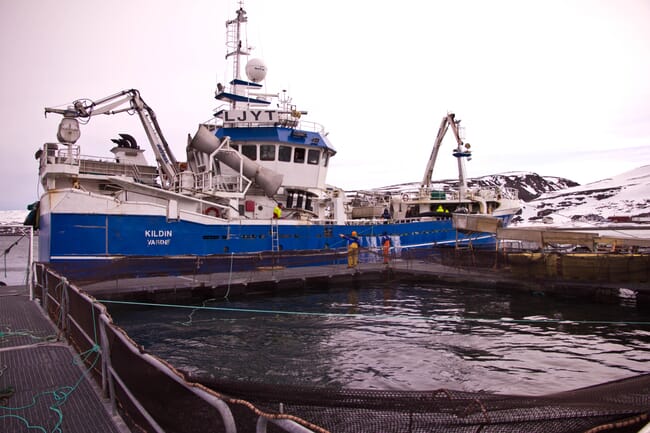A report published by Nofima this week shows that the live catch quota bonus is helping more fresh cod to be delivered outside the main winter season. This has been deemed desirable by the Norwegian authorities in order to provide a more stable supply and predictable situation for the fish processing industry and better utilization of high value fresh fish market.

© Nofima
Also known as capture-based aquaculture, it represents a new way of fishing, which requires new knowledge and development. To encourage this, the authorities have created a scheme called “live storage bonus”. This enables fishermen who store the catch in cages for more than a week, to have part of this total subtracted from their quota.
When the scheme was introduced in 2008, this reduction was 20%, while since 2013 it has been at 50%. The scheme is intended to be temporary, to help the industry get going, but the figures show that it is working. More fishermen are storing their cod catch live, and the volume of live-stored fish has also increased significantly.
In 2017, 4,000 tonnes from the total cod quota has been set aside for the scheme, and about 5,750 tonnes were stored live.
“The cod is stored live for an average of around three months. Also, live-storage fishing takes place around one month later than traditional fishing. This means that we get more fresh cod, especially during the summer. But the effect for the rest of the year is minimal, and the vast majority of players have chosen to store the fish for a relatively short period,” says researcher Øystein Hermansen.
So far, the incentive scheme has not provided much knowledge regarding storage over longer periods – in particular, relating to the market opportunities.
More knowledge needed
Industry representatives believe the scheme should last another three to five years before sufficient knowledge has been gained for the practice to continue without the live-storage bonus. There is a degree of uncertainty among industry regarding the continuation of the incentive scheme, and this has negatively influenced their willingness to invest in this way of storing the catch. In the evaluation report, the researchers propose a number of adjustments to improve the schemes.
To prevent illegal landings, the authorities could consider stricter requirements for documentation, and use sanctioning options, for example, exclude players from the live storage scheme if regulatory violations are uncovered. Documentation and sharing of information about the conditions during the catch and survival at different stages may also increase the learning effect for other players.
Researchers also believe that a system that would provide incentives also for storage plants. A major reason why few plants have chosen long-term storage of fish are the requirements for both permits and the location of such businesses. Both the distance requirements for other aquaculture operations and the requirements associated with risk assessments related to infection have proven difficult to fulfil. The researchers recommend that the authorities review the regulations to establish if the risk assessments are reasonable.
Value creation?
Live fishermen have greater catching costs than for traditional fishing methods, and storing the fish is an additional cost, but the sales price is also higher and the fish can be used in more products.
Moreover the report reveals that "feedback from industry players is unanimous – they want the schemes to continue, preferably in an improved form".




